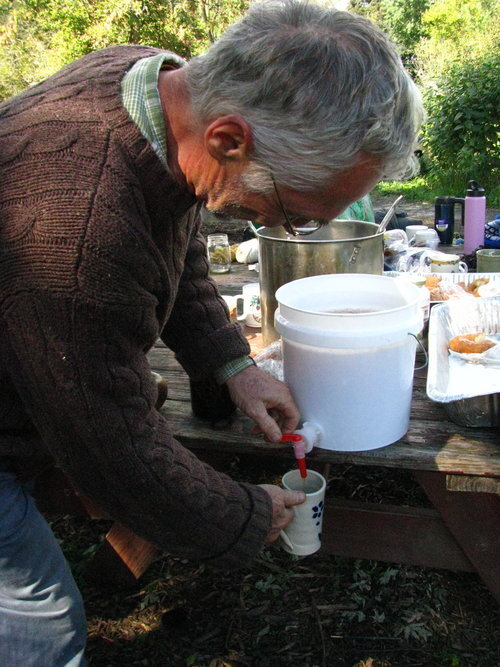Apple




Apple
Malus spp.
Plant for the lore, for the wildlife feasts and resilient rootstock, for smoking meats and heating homes, and for cidermaking and wassailing!
Hardy from Zones 3-9. Up to 30-35 feet tall and 20-30 feet wide. Needs a buddy to cross-pollinate.
Old Apple tree, old apple tree;
We've come to wassail thee;
To bear and to bow apples enow . . .
There’s supposedly nothing more American than Apple pie. Which says a lot about America because that dessert isn’t from here, and neither are most Apples! Apple might have been one of the first cultivated years, growing up in the Tian Shan Mountains of Kazakhstan, Kyrgyzstan, Tajikistan, and China. Now there are over 7,500 cultivars of Apple, and they’re all over the place! China is the largest producer of the fruit, with the U.S. second, and the trees have acclimated to the high mountains of Ecuador where they can produce two crops in a single year.
Apple is a member of the Rose family, which is evident from the brownish-gray bark with blushing overtones and the gorgeous pink and white flowers. They like mild shade to full sun and their shallow roots grow well with deep-rooted understory companions. Apple lore is full of mythological and religious significance, from erotic love to sinful seduction. Norse and Germanic gods of fertility were associated with the fruit and golden apples got thrown around a lot in Greek mythology, mostly as a declaration of love and a symbol of desire and destruction. The infamous forbidden fruit in Genesis came to be known as Apple because the Latin words mālum (apple) and mălum (bad) are usually written without accents. Aquila Ponticus translated the Hebrew Scriptures into Greek and decided that the Tree of the Knowledge of Good and Evil must be the same one symbolizing desire and destruction for Olympian deities. However, until the 1600s apple was a pretty generic term for all foreign fruit and nuts, so who knows what some of these folks were referring to. We do know that Apple is the fruit of the Old English custom of wassailing, a custom that continues today. Appropriately, the word comes from an Anglo-Saxon greeting to “be of good health,” because farmers gathered in their Apple orchards on the Twelfth Night of Christmas to wake up the cider trees by drinking and singing to their health. The songs, aided by hearty bowls of mulled cider, were also meant to scare away any hidden spirits that might steal the fruit. Wassailing might also have been a little strategic exchange from Medieval peasants to the lords: “we’ll give you goodwill if you give us food and drink.”
European colonizers brought Apple seeds to North America in the 17th century and spread them along coopted Native American trading routes. In fact, Apple was one of the most widely planted trees for so-called land improvement under the Homestead Acts, which the U.S. government passed to incentive westward colonization on stolen Indigenous land. Planting Apple from seed led to incredible diversity because Apple seedlings are extreme heterozygotes, which means they’re really different than their parents, which could mean wide variations in taste and hardiness. Most Apples are propagated by grafting onto rootstocks of different sizes, cold hardiness, disease resistance, and soil conditions. John Chapman, better known as Johnny Appleseed, is the most fabled seed-sower, which he did because of their creative variations and because he believed grafting was a sinful fusion. He collected bushels of seeds to plant in the Midwest for cidermaking until teetotalers campaigned to burn down the alcoholic trees. Despite temperance-based pruning, most apples in the United States were turned into cider as a safe substitute for drinking water. Cidermaking waned for a while, but here in Virginia we’ve seen a revival mostly advertised as an American heritage dating back to the Founding Fathers. However, enslaved Africans – men, women, and children – planted most of the trees, selected most of the best varieties, and fermented most of the juice with styles from their homelands, so whose heritage is it really?
Not all Apples are colonial newcomers to this continent. Crabapple is the only indigenous malus tree, though Europe also has native Crabapple species that crossed with Asian varieties to produce most domestic cultivars. Crab is often a rootstock for these cultivars because of its cold hardiness, disease resistance, and water tolerance, often found on wet edges of woods and hedgerows. Crabapple can grow tall from seed, which is what we’re doing. The sour fruit isn’t considered an important food crop, but we’ve found sweet exceptions for sauce and chutney. Our trees will grow well as landscaping, as pollinating support for other trees, and as excellent wildlife food. The wood can also be coppiced for fragrant firewood that burns slow and hot, to warm your house or smoke meats. We mostly harvest crabapples for cider mixes with other apples and pears, as well as some batches of straight crab for sours! The fruits are nutritious and loaded with pectin for spicy preserves and juice, which is why it’s one of the nine plants referenced in the Nine Herbs Charm, a 10th century English herbal spell for healing infections.
We propagate our Apple seedlings from sweet abundant hardy trees. This year, we grew out seed from fruit we harvested in abandoned juice and cider orchards in our county. We pressed and raked the pomace into nursery beds.